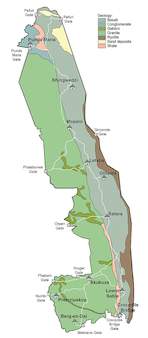

Kruger's geology is relatively simple. The western half of the Park consists primarily of granitic soils while the eastern half rests on a foundation of basalt. The granite domes of south western Kruger are among the oldest rocks in the world, dating back 3,5 million years. There are isolated granite inselbergs across Kruger, the most prominent being the string of koppies visible south of Skukuza.
Kruger is separated from Mozambique by the Lebombo range - low, rocky, rhyolitic foothills that run from north to south. The only other mountainous terrain in the Park is found in the south-western foothills between Pretoriuskop and Malelane, and in the far north where the eastern Soutspansberg spills over into the Park.
The sandveld north of Klopperfontein, especially in the Luvuvhu and Limpopo River valleys, has its own geological personality which, combined with its tropical latitude, gives the landscape a character that is altogether different from the rest of Kruger.

